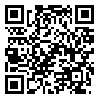BibTeX | RIS | EndNote | Medlars | ProCite | Reference Manager | RefWorks
Send citation to:
URL: http://jsdp.rcisp.ac.ir/article-1-448-en.html
As a Brain computer interface system, BCI P300 Speller tries to help disabled people and patients to regain some of their lost ability with allowing communication via typing. The ability of personalization is one of the most important features in a BCI system, so the typing language as a personalization factor is an important feature in a BCI speller. Most prior researches on P300 Speller has focused on displaying English alphabet and there were only few studies made on other languages such as Chinese. In this research, we present a P300 Speller system, based on RCP, for Persian (Farsi) character input.
RCP (Row or Column Paradigm) was introduced by Farwell and Donchin at 1988, and since then it has been considered as a benchmark in P300 BCI speller research. As a result, in this study also, Row or column paradigm was selected as the base stimulation pattern in P300 speller system.
In order to evaluate the Persian row or column paradigm performance, we recorded EEG signals from volunteered subjects while the stimulation pattern was being displayed. It should be noted that the test was explained to each subject before testing, and for more experience and in order to reduce the error, each subject participated in an experiment test before attending the main test. These EEG signals were recorded from 8 channels based on ‘‘Fz’’, ‘‘Cz’’, ‘‘P3’’, ‘‘Pz’’, ‘‘P4’’, ‘‘O1’’, ‘‘Oz’’ and ‘‘O2’’ site in accordance to the International 10–20 system electrode placement system and by using Science Beam co.’s EEG recording device. The sample rate was 1 KHz which was down sampled to 250Hz. After recording, the EEG signals were filtered using a band passed filter And for classification, Linear discriminate analysis was used in combination with K-fold validation method for classifier training.
As performance determination, we calculated accuracy and bit rate for the mentioned system based on recorded data from volunteers and reached the average accuracy of 88.21% and bit rate of 6.74 (bits/minute) (we use Linear LDA classifier for classification and the total trial number was set to 15). Furthermore, in this research performance was measured for different trial number and final results demonstrated that this system can achieve high average accuracy of 80.06% and average bit rate of 42.43 (bits/minute) by using only 2 repetitions.
Received: 2015/10/27 | Accepted: 2017/03/5 | Published: 2017/10/21 | ePublished: 2017/10/21
| Rights and permissions | |
 |
This work is licensed under a Creative Commons Attribution-NonCommercial 4.0 International License. |






